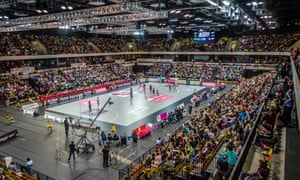There was something different about the crowd noise in the Copper Box and it took me a while to work out what it was. About 10 minutes into the first quarter of the game, I realised: it was the octave level. The netball match was a sell-out – a high-stakes encounter between Hertfordshire Mavericks and Surrey Storm – and the 6,000-capacity arena thrummed, as it’s designed to do, with the cheers and shouts that ricocheted around its walls. But where was the bass? This crowd was all about the treble.
I’d never been at a sports event where the spectators were so overwhelmingly female. Here was an audience that was no less passionate or knowledgeable, but who expressed themselves with a distinct lack of baying and booing. The young girls who had come with their mums, and the teenagers who’d arrived as a pack, yelled instructions and pleas to their players without the sarky cynicism of the world-weary season ticket holder.
As for me, my courtside seat – courtesy, full disclosure, of Sky, the Superleague’s host broadcaster – made me feel like Beyoncé watching the Brooklyn Nets at the Barclays Center. I was so close to the action that when things were looking sticky mid-court, I was tempted to jump up and yell “I’m free”.
Netball’s one of those games I used to love playing as a girl, but it never occurred to me to follow as a fan. The scorelines were off-putting – a sport that averages 100 goals sounds a bit repetitive to watch – and it never occurred to me that its beauty as a spectator experience lies not in the scoring but in the athletic ability of its players around the court. The ball zips around continually, its progress plotting a swift, almost mathematical course, and the two teams move with it, the marking so close, the anticipation so fast that they appear a single organic entity.

It’s also a sport made for TV: fast-moving, high-energy, all action, with stoppages that are perfect for ad breaks. It’s highly physical – technically non-contact in the way that Bill Clinton was technically faithful to his wife – and there’s plenty of scoring. The whole game is neatly contained within a conveniently sized rectangular frame. But there isn’t a lot of netball on TV and that’s because, these rare Copper Box showdowns aside, the game is played in university sports halls to crowds of 800 or so.
How has such an engaging sport struggled to find an audience? Is it because it’s played solely by women? There are places in the world that get netball: in Australia, New Zealand and Jamaica, a player can be a bona fide star. But the game has struggled to be taken seriously beyond Commonwealth countries and in England it’s treated like a niche activity, despite being the country’s biggest female team sport. Denied a place at the Olympic Games, it doesn’t receive the benefit of that exposure boost that helps out, say, hockey on a four-yearly basis.
Which is ironic because here, at a mere domestic match, the feats of athleticism made the game look like an Olympic highlights montage. The players leapt like high-jumpers; they moved across the floor like sprinters coming out of their blocks. They had ball-handling skills worthy of an All Black, the balance and precision of a Russian gymnast. Put an emotive soundtrack behind it and stick a hashtag on it, you’d have a ready-made #ThisGirlCan advert.
Looking at the quality of England’s netball, it can seem almost counterintuitive that the frontline battle for gender equality began with sports such as football, rugby and cricket. Sports that few women traditionally played in school or at clubs – where the participation base was low and the standard so variable – were always likely to suffer from a negative comparison with the men’s game. Yet the one team sport that most of the women in the country have played at some time or another, a game that showcases female athleticism at its best and arrives free of any suggestion that the men can do it better, finds itself far behind in terms of sponsorship, coverage and professional pay.
Of course, the campaign for women’s sport to be treated equally with men’s has to fight on all fronts and the advances made by each sport will bring benefits to all. Still, watching the players bounce around, filling their confined space like compressed gas particles in Brownian motion, it struck me that the game doesn’t reward orthodoxy as much as it does quick‑thinking and resourcefulness. Sling the ball, lob it, bounce it – hell, you can roll it along the floor if it’ll do the job you need. Perhaps a little unorthodoxy could prove useful in the presentation of women’s sport: it’s not always about proving that we’re just like the guys. Sometimes it’s about celebrating our difference.



